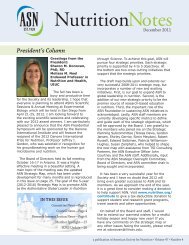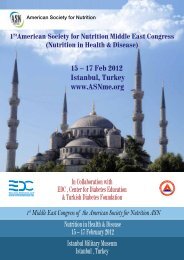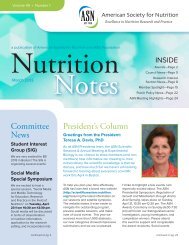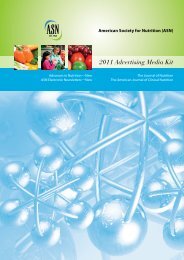Onsite Program & Exhibit Guide - Amazon Web Services
Onsite Program & Exhibit Guide - Amazon Web Services
Onsite Program & Exhibit Guide - Amazon Web Services
You also want an ePaper? Increase the reach of your titles
YUMPU automatically turns print PDFs into web optimized ePapers that Google loves.
with 10-6 M phenylephrine. Results: Endothelium dependent<br />
vasodilation was impaired in high fructose solution fed group<br />
in comparison to Sucrose group (high fructose corn syrup<br />
%37.8±7.6 versus sucrose %60.5±5.9, mean±SEM, n=11, n=8<br />
respectively; P< 0.01 t-test)<br />
Conclusions: Since high fructose corn syrup is widely used in<br />
food industry, our findings implicate that high fructose intake<br />
might be a factor that contributes to the development of<br />
vascular dysfunction that leads to cardiovascular diseases. The<br />
mechanisms that impair the vascular endothelium by high<br />
fructose consumption warrant further investigation. These<br />
mechanisms might include a different kinetics of digestion<br />
and absorption of fructose versus sucrose, an altered response<br />
of the secretion of metabolic hormones and/or metabolic<br />
disturbances such as altered lipid metabolism induced by high<br />
fructose consumption.<br />
15. Betaine administration accelerates liver regeneration in<br />
hepatectomized rats via its effect on the transsulfuration<br />
reactions<br />
Young C. Kim, Sun J. Kim, Young S. Jung, Do Y. Kwon<br />
Seoul National University, College of Pharmacy, Seoul, KOREA<br />
Objectives: The liver has the remarkable capacity to<br />
regenerate itself after injury. Our previous work has shown<br />
that hepatic S-adenosylmethionine (SAM) level critically<br />
influences the liver regenerative process via regulation<br />
of polyamine metabolism. In this study we examined the<br />
progression of liver regeneration in the rats treated with<br />
betaine, a methyl donor that is known to enhance the<br />
generation of methionine and SAM in liver. Methods: Male<br />
rats were provided with betaine (1 %) in drinking water<br />
following two-thirds partial hepatectomy (PHx). An additional<br />
group of rats received betaine for 2 wk prior to the surgical<br />
treatment. Liver weight/body weight ratio (LBWR) and serum<br />
enzyme activities were determined for 7 days. Expressions of<br />
cyclin D1 and proliferating cell nuclear antigen (PCNA) were<br />
monitored for 2 days after PHx. Major metabolites/products in<br />
the transsulfuration pathway as well as polyamines were also<br />
quantified in the remnant livers. Results: Liver weight growth<br />
was significantly greater in the rats treated with betaine than<br />
in the control rats starting from the second day following PHx.<br />
The betaine-treated rats retrieved the liver weight fully in 7<br />
days, while the liver weight in the control hepatectomized rats<br />
reached 80 % of the normal liver. PCNA protein expression in<br />
liver was significantly greater in the betaine-treated rats when<br />
measured at 24 and 48 h following the surgery. Induction of<br />
cyclin D1 expression was accelerated in liver of the betainetreated<br />
rats from 12 h after PHx, and remained elevated for 24<br />
h compared with the increase in the control hepatectomized<br />
rats. Major metabolites/products in the transsulfuration<br />
pathway including methionine, SAM, cysteine, glutathione,<br />
and taurine were all increased in liver of the hepatectomized<br />
rats. Among the changes in the sulfur-containing substances<br />
provoked by PHx, the increases in methionine and SAM levels<br />
were intensified significantly in the rats provided with betaine.<br />
The surgical treatment elevated putrescine and spermidine,<br />
but decreased spermine levels in the remnant livers. Betaine<br />
administration markedly enhanced the elevation of putrescine<br />
and spermidine levels in the hepatectomized rats.<br />
Conclusions: The results show that betaine is capable<br />
of accelerating the liver regenerative process after PHx.<br />
The elevation of hepatic SAM, a metabolic substrate for<br />
polyamine synthesis, appears to play an important role in<br />
the enhancement of liver regeneration in the rats provided<br />
with betaine. It is suggested that betaine may be useful as<br />
a therapeutic liver-regenerating agent, which promotes<br />
improvement or normalization of hepatic functions both in<br />
the remnant liver and in the transplanted liver.<br />
16. Raiding the fridge for comfort: An exploratory<br />
qualitative study of emotional eating in women over 30<br />
Dani Nordin, Lesley University, Cambridge, MA<br />
Objectives: This exploratory qualitative study attempts<br />
to clarify the relationship between emotional eaters (i.e.<br />
individuals who respond to negative emotions by eating)<br />
and the foods they consume during emotional episodes.<br />
Of particular interest are the types of emotions that elicit<br />
overeating behavior what types of foods tend to be preferred,<br />
and when the eating behavior happens in relations to<br />
the emotional stimulus. Focus is on emotional eaters who<br />
regularly eat in response to depression or stress, but who are<br />
not binge eaters. Methods: An initial convenience sample of<br />
6 self-described emotional eaters was recruited for semistructured<br />
interviews in person or over Skype. All subjects<br />
were white woman ranging in age from 33-55, with a median<br />
age of 36.5. Mean BMI was 30.3 (range: 23.6 – 37.1) and all had<br />
experienced significant episodes of depression more than<br />
once in their lives. All subjects completed the Three-Factor<br />
Fating Questionnaire, and received a mean score of 2.86 out<br />
of 4 for the Emotional Eating subscale. All interviews were<br />
recorded and coded to uncover thematic similarities among<br />
the participants. Results/Implications: The most significant<br />
finding in the study was that each participant preferred to<br />
engage in their emotional eating behavior when they were<br />
alone and wouldn’t be observed, regardless of when the<br />
emotional stimulus occurred. Another interesting result was<br />
that for most of the women, emotional eating behavior was<br />
a pattern that repeated itself over a series of months, rather<br />
than occasionally in response to a single emotional stimulus.<br />
Further, these periods of emotional overeating were generally<br />
accompanied by significant weight gain (range: 20-60 pounds)<br />
followed by periods of normal or strained eating which<br />
would lead to weight loss. The results of this study, although<br />
preliminary, suggested that experimental methods which look<br />
for an immediate temporal relationship between emotional<br />
stimulus and overeating behavior may be ineffective as a<br />
means of understanding emotional eating behavior. Diary<br />
studies, which focus on both mood state and total intake,<br />
including mealtimes, may be more effective at seeing this<br />
relationship. Conclusions: The currect research suggests<br />
that longitudinal, diary-based studies which look at overall<br />
consumption vs. daily mood over longer periods of time may<br />
prove more effective than experimental methods as a means<br />
of understanding emotional eating behavior, particularly<br />
of focused on overall consumption rather than total snacks<br />
consumed. Future research, involving a larger number<br />
of individuals, is needed to reinforce these findings. The<br />
relationship between emotional eating behavior and weight<br />
gain also suggests that behavioral approaches to weight<br />
21








